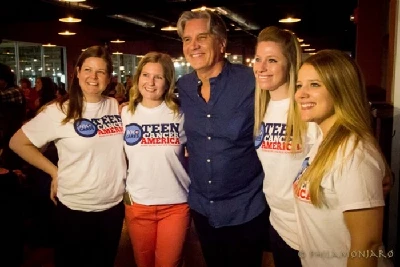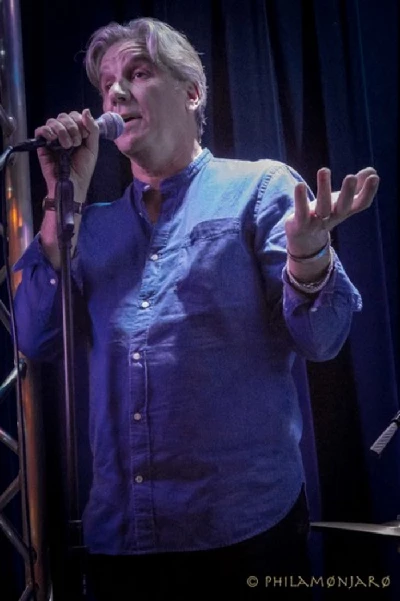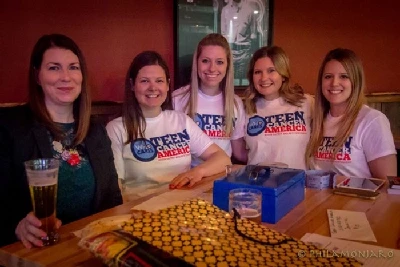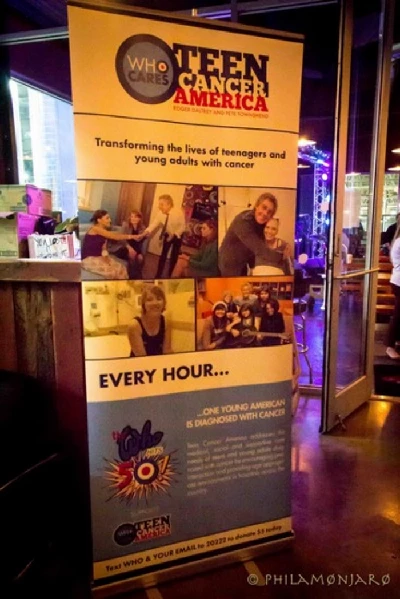published: 21 /
5 /
2015

Simon Davies, former director of UK-based Teenage Cancer Trust and now executive director of America-based Teen Cancer America, discusses the organisation's goals, current focus and the involvement of Roger Daltrey and Pete Townshend from The Who in it
Article
In February of 2013, Pennyblackmusic ran an interview with Teen Cancer America and spoke to Rebecca Rothstein and Mindy Brooks from its board. They discussed the organisation’s vision and the important work being done to support teens and young adults, by establishing age-appropriate, specialised pediatric units for thirteen to twenty-five year-old cancer patients in American hospitals.
Two years later, I have the opportunity to speak by phone with Simon Davies about his important role in the organisation. When I ask him about his beginnings, he seems anxious to move on to more pressing matters.
“I’ve lived most of my adult life in London. I’m actually from a small, coastal town called Felixstowe, that nobody will know, which is on the east coast of England,” he tells me, and he’s right. I have no idea where it is. I’ve never heard of it, but I have heard a lot about Simon Davies and the well-respected Teen Cancer America.
But before Teen Cancer America came about, Simon Davies served as the CEO of the UK-based Teenage Cancer Trust from 2000-2013, after having already devoted countless professional years to the fields of health and social work.
With few resources but with undisputable perseverance and passion, Simon and his colleagues efficiently built that organisation up, establishing lasting relationships with medical professionals in pediatric and adult units and working diligently to research and improve the quality of life for youthful populations, who suffered from various types of cancer. When Teen Cancer America asked Simon to head its overseas disciple two years ago, he accepted the challenge, although it meant relocating and conceptualising a new programme in a new country, almost from scratch.
Fast forward to 2015. Teen Cancer America’s track record is truly inspirational, especially considering the short amount of time it has been operational. Multiple units have successfully been developed on both American coasts, and it appears that more communities in the Midwest will have their wishes granted as soon as funds become available.
I talk to Simon about five days before he is scheduled to attend a Chicago benefit in which money would be raised for a new unit designed in conjunction with the University of Chicago Hospital, Comer Center.
“We’ve been encouraging anybody who wants to get involved to host a simple event for Who fans and charity supporters together to see if we can grow our base in that area and get good support,” he explains, with a great deal of enthusiasm.
The fundraiser, featuring a concert by Chicago’s local branch of School of Rock teens and the Chicago Chamber Orchestra, will be held at the upscale brewery, Lagunitas. It has been co-ordinated to coincide with the fifty year anniversary tour of The Who, which features Pete Townshend on guitar, Simon Townshend on guitar, Pino Palladino on bass, Loren Gold, on keyboards, Zak Starkey on drums and Roger Daltrey, the legendary lead singer, whose commitment has been the bedrock of the foundation. Two days later, a second charity concert will take place at Chicago’s Rosemont Theatre. Entitled, ‘Celebrating The Who’, this Teen Cancer America benefit concert will feature Who guitarist/songwriter Pete Townshend, Pearl Jam’s vocalist/songwriter Eddie Vedder as well as guitarist/songwriter Joe Walsh and singer/songwriter Joan Jett.
The Who donates proceeds from their concerts to the cause and promote the vision at every turn. Moreover, rock singer, Daltrey, is frequently seen in specialised teen/young adult cancer units, bonding with the teens and young adults, spreading the word about the mission or performing impromptu concerts.
The Who have frequently enlisted fellow musicians to support the cause: Dave Grohl, Eddie Vedder and the list goes on. Maybe some musicians get on board because of Roger Daltrey’s invitation, but when they meet the teens and young adults and see how they can mingle with one another in their own space they come back again and again.
Simon has piqued my curiosity about his birthplace so I surf the net to find out more about that little-known locale. I find that the town not only boasts classic Art Deco buildings, but that it was the home of T.E. Lawrence, the Rt. Hon. Arthur Balfour, who would become British prime minister, and the Duchess of Windsor. British actress Hayley Mills also enjoyed the tranquillity during the summer months.
That said, this tiny spot on the map has launched some mighty powerful career paths.
It’s all a bit like what happened with Teenage Cancer Trust and then Teen Cancer America. The seed of a brilliant idea grew and blossomed despite limited supplies and monies and a few naysayers who didn’t quite recognise the urgency. That seed has been cultivated and nourished. That said, for all concerned it’s been a bittersweet journey, but, with a strong emphasis on youth medical trials and with bills in place that secure the rights of youth, things can only move forward.
It’s about what one can achieve through caring about others or placing the needs of others in front of their own. It’s about the many teens and young adults who dealt with physical and emotional pain yet felt obliged to reach out to others with advice, support and friendship. This article is dedicated to the brave youth that reach out to the community at large, despite their daily challenges and to the adults that clear the path. For more information, contact: info@teencanceramerica.org
PB: It was the early part of 2013 when I first spoke to Teen Cancer America board members and so much has happened since then.
SD: I think it was before I got there. I didn’t come until September.
PB: So what are you looking forward to when you attend the benefit next week?
SD: I like the ideas that there are teenagers in a rock band supporting other teenagers. It has a nice ring to it, doesn’t it?
PB: Definitely. You worked with Teenage Cancer Trust for thirteen years. You got married. You moved to America. You set up Teen Cancer America. You’ve gone through some amazing transitions
.
SD: Yes, it was quite extraordinary. In fact, it sounds dramatic saying we got married, but we’d been together for forty years. It wasn’t that big of a leap.
PB: But moving to America and starting the new programme from scratch?
SD: We really came because the charity was having difficulty finding someone who had the experience to run it, so things aligned for us in the UK and then we were able to get out here in September. Yeah, when you look back, there has been a lot of development happening.
PB: Was it difficult to get hospitals in Chicago and the Midwest interested? When I first spoke to the board members, things had not yet materialised.
SD: I’d been out probably in November to Chicago, and we went to see them at the University of Chicago Children’s Hospital. They were sort of interested, but it didn’t follow up very quickly. It took a little bit of time and then, of course, this opportunity came up, so we were able to reconnect and say, “Now there’s money attached to it,” and that made a big difference to our conversation and they’ve come up with some good plans. The lead doctor, there, John Cunningham, is great and I think we’ll deliver something very good for them.
PB: I remember communicating with Alexis Reilly, who had been a patient in a Teen Cancer America unit and had been instrumental in designing subsequent units. Is this something that will typically occur? Will you have young adults who have been through the programme helping out in this way?
SD: Once we’ve appointed an architect or interior designers, we always want to get young people involved in that process, getting them involved in what’s built and what we deliver. We make that a requirement in the hospitals and they’re very happy to get young people involved. Yeah, we’ll definitely do it.
PB: What is the role of the Teen Cancer America youth ambassador?
SD: We have two types of ambassadors (There are also “celebrity ambassadors” LT). We have ambassadors that are young people, who have been through cancer and what we’re trying to do is develop a network, a nation of young people who are prepared to get involved and we’ve not pushed a great deal on them at the moment, but they can help us with giving our voice a national focus by giving us their views on specific things that we want to see developed and giving us their ideas, but also on a local level. If we’re engaging with a hospital, we can call on our local ambassador who lives nearby to help us with that development.
PB: Hernan Barangan is working on a documentary, ‘Road Rebellion’. He calls his circle of friends “cancer fighters.” His vocabulary is very empowering. He has asked, “What does it take to not leave anybody behind?” The project seems very inclusive, drawing from a unique set of voices. Would you please update us on the progress of this ambitious film and explain how it came to be?
SD: Hernan has been through cancer twice himself, so he’s had that experience. As a result of that treatment, he’s ended up in a wheelchair. He’s an extraordinary young man, but he’s also a very, very good filmmaker and I saw some of the filmmaking that he was doing in L.A. with the advisory group, with the hospital here, with the young people. I was just blown away by it. I thought it was incredible. And, actually, he and I came to a meeting together with exactly the same thought: We need to capture the voice of America.
So, we had this idea of finding sponsors so we could support him to go to every state in the US and to interview a young person and he’s pretty much done that now. He’s literally today come back from Hawaii and he’s actually been to every state in the country, but there are three that he has to go back to because the young people there weren’t able to see him, so he’s got to go back just to South Carolina, Delaware and Rhode Island.
He’ll be setting off there in about eight days’ time and he will have those final films done and then he will have this incredible catalogue of the voices of young people across America, and so there are three purposes to what we’re trying to achieve with that.
First is that, when I’m going to hospitals, particularly hospitals that don’t know us or know our work, I will have a film of somebody of that state that the hospital is in, and so, rather than show some young person from L.A. speaking, I’ll be able to have a young person from that state talking about their experience and why they think it’s important to develop a special facility for young people, which will be very powerful.
He will also produce for me a fifty-person edit, which will be something that I can use at national conferences, and, as we may do, go and speak to politicians about trying to change this, that will be an option to have all of those young people represented in one film.
PB: What would you expect to happen after showing the film to politicians?
SD: If we get the opportunity, ever, either on a regional level or if we’re on Capitol Hill, to be able to talk about the needs of this age group and the changes that need to take place in America to accommodate them within the health system properly, then that’s the way in which I would want to utilise a valuable tool like this, communicating, getting the sense that this is something that is universally felt by young people.
The third component is that Hernon is going to make a documentary about his experience. He made one already when he was half way around and that got shown at the Cleveland Film Festival to very good critical acclaim. He will make a final edit of the whole journey and we’ll make a documentary, which we hope will be broadcast because it’s such a great story.
PB: I did see some footage in which people not directly involved in the film expressed great interest in having units build in their communities. By travelling and opening up, Hernon and the young adults he interviewed really cast a wide net.
SD: Yeah, I think it’s an incredible piece of work and it’s extraordinary to see that he’s almost completed it. He’s very creative. The quality of his film work is great.
PB: Simon, you have cited alarming statistics regarding individuals between the ages of 13 through 25, about how every hour this group gets diagnosed with cancer. In some cases, there are young adults being diagnosed with stage IV cancer. Is this because the young people have such busy lives that they don’t regularly visit doctors? Is it because sometimes young people consider themselves invincible?
SD: There are a number of things that contribute to young people diagnoses being delayed. Young people play their own part, for sure, that thing about being invincible, not wanting to go to the doctor, maybe not sharing soon enough with adults. If they have something wrong with them, they’ll wait, that sort of thing.
Then, even within families, there’s a tendency to think that teenagers don’t get sick. Sometimes that can happen and there will be a family delay. Also, at the primary care level with doctors, they don’t look for cancer. They don’t expect it in a young person of that age, and not all of them are looking for it.
Quite often you’ll hear a story about bone cancer, where people have been told, it’s probably growing pains or “maybe you have a sports injury, don’t worry about it,” that it will go away and then their having to go back and be persistent about getting an appointment, and so all of those things can lead to delay before the diagnosis is made. Even then there are occasions where treatments start in a place that it shouldn’t, so it may start in a community hospital where they don’t have the expertise to deal with a rare cancer—young people tend to get rare cancers, though they may get to a specialist in an academic facility later then they should. There are all these challenges that are out there.
PB: What is the overall plan for Teen Cancer America in terms of scouting out additional locations?
SD: We want to develop facilities in every hospital we can that should have one in the USA. so there are two hundred pediatric hospitals in the US and many, many more, I don’t know the exact numbers. Adult hospitals and these facilities can be in either or both of those, and so there’s a lot of hospitals there.
We’re currently working with eleven intensively and we’ve got over forty, probably close to almost fifty now, hospitals that are interested and so we’re out there trying to help them with their programmes.
PB: Clearly to run this organisation you need adequate funds, but what about other contributions? Let’s say I’m an eighteen-year-old musician without resources. Is there something I can do for Teenage Cancer Trust or Teen Cancer America? Is there a way to participate in the cultural bandwagon?
SD: Well, certainly, it’s not all about money. If you’re a young musician and you’re interested in the story, most of them have got good social media networks; they can get information out to their families about the charity. They could come to us and find out more so they would be able to talk about it if they ever got any media opportunities. They can tell their friends the story of why they should get behind it.
There are simple ways of bands raising money. It doesn’t mean they have to give up all of their time for free. They can add a dollar to the ticket of their show, or, instead of getting their guest list passes for free, they can give ten dollars. We have texts to donate or they can send people to our website to try to donate some money, but just to have their support is great. So, we need to get out there into the country, into the regions and to the places where young people are, to get the message out about all that we’re trying to achieve.
PB: The Teen Cancer of America Board includes people with expertise in real estate, finance, music management and film. I imagine that this diversity allows you to conceptualise your goals, using many perspectives.
SD: It’s a fantastic board and they’re all committed. We have the opportunity to call on them for support when we need it. They’ve got people on the medical side helping us, people out there networking and bringing new people to us, so we’ve put on great events. We’re very lucky.
PB: Roger Daltrey is passionate about the charity and at Who concerts the band gives fans the opportunity to text donations and hear about the latest news, but how involved is Roger offstage at this point?
SD: Very.
PB: How so?
SD: Roger has been a champion of this from the start. That’s why we’re all here, to be honest with you. He wanted to bring it to the Unites States in the first place. He’s very, very interested in how it’s developing and what it can do. As you know, they’re on tour at the moment, so he’s made sure that the film about the charity at work is being shown at every concert. He’s doing press related to it. He’s meeting teenagers and young people. He’s meeting people that are prepared to help get behind the charity. He’s very hands on. He’s a fabulous ambassador for us. It’s incredible to have him as our founder. We’re very lucky.
And, Pete, too. Pete’s doing a fundraiser for us in Chicago with Eddie Vedder. Roger’s more of the front man, but Pete cares about it, too. He helps Roger where he can.
PB: I know you’re also a Who fan. What are some of your favourite songs?
SD: Everybody likes ‘Baba O’Reilly’, don’t they? A bit of an anthem for us is ‘My Generation’ and I’ve always liked the ‘Who’s Next?’ album. I think those are the main ones that I personally like.
We have such fun with The Who fans because there’s such a great debate about what are the best songs. They’ve got an amazing following. It’s incredible.
PB: Thank you.
Photos by Philamonjaro
www.philamonjaro.com
Picture Gallery:-


